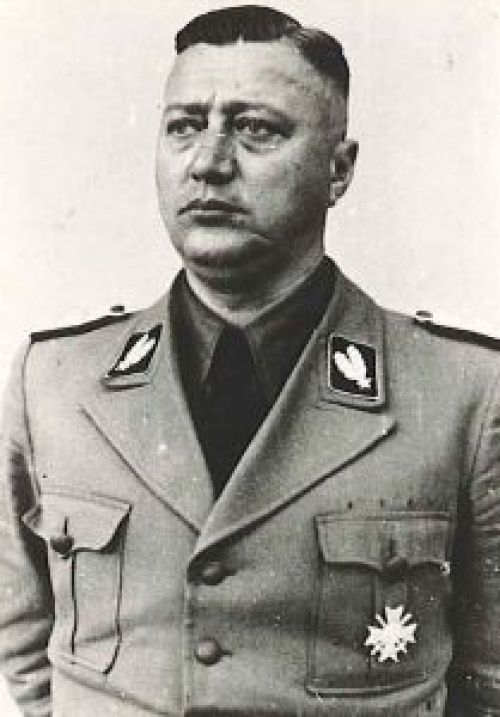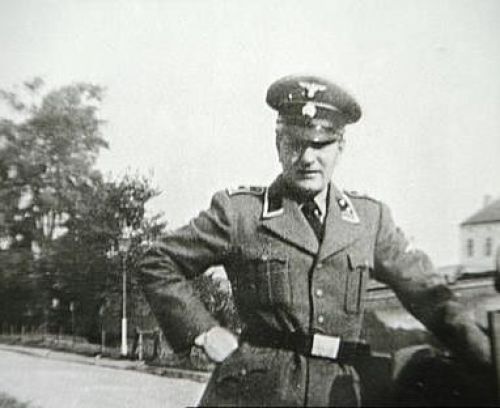Eberhard Schongarth

Eberhard Schongarth (Private Archives)
Eberhard Karl Schongarth was born in Leipzig on 22 April 1903. He studied law achieved a doctorate and first joined the Nazi Party in 1922 but left the same year. After serving in the army during 1924 he worked as a university professor in Leibnitz. He rejoined the NSDAP in 1933 and joined the SS on the 1 March 1933 as well as the Prussian Gestapo in 1935. From November 1935 to 1936 he was assigned to the press section in the Berlin Gestapo and during the first half of that year also acted as a political lawyer. He was in charge of the Gestapo office in Arnsberg from May 1936 through 1937 and was commissioned as an SS-Untersturmfuhrer on the 9 November 1936.
He was assigned to the SD Hauptamt (later the RSHA) from November 1936 to October 1939 and was promoted to SS-Obersturmfuhrer on the 30 January 1938, to SS- Hauptsturmfuhrer on 20 April 1938 and to SS-Sturmbannfuhrer on the 1 August 1938. Schongarth was promoted to SS-Obersturmbannfuhrer on Himmler’s orders on the 10 September 1939. Schongarth headed a number of Gestapo offices in Bielefeld during 1937 -1938 then Dortmund in the first quarter of 1938 and Munster. He was the Senior Inspector of the Sipo and SD in Dresden from early October 1939 until he went to the General Government in January 1941. Scongarth was promoted to SS-Standartenfuhrer on the 1 January 1940 and was also made an Oberst der Polizei on the 1 March 1941
Schongarth was based in Krakow he was Senior Commander of the Sipo and SD to mid-June 1943, he was promoted to SS-Oberfuhrer on the 30 January 1941. Dr Schongarth was characterised by an outstanding fast intellectual grasp, strong willpower and an impressive appearance. Schongarth was a bulky figure, which commanded respect and obedience. He was energetic, very lively, a regular drinker and not without a sense of humour. He enjoyed “beating up “his men and to use drastic expressions. These outbursts were not seriously meant often accompanied by a “wink of the eye.”
Dr Schongarth experience and high position within the Security Services of the General Gouvernement and his political approach led to his Chief of the RSHA Heydrich to attend the Wannsee Conference on the 20 January 1942, where the “Final Solution of the Jewish Question” was discussed.Dr Schongarth was a fanatic enemy of the Jews, he believed their extermination necessary and wanted to harden his Sipo-SD Fuhrers with the necessary “steel hardness.”
Schongarth’s uncompromising stance is demonstrated in regard to the execution of the Jews in Lvov by officers under his command – that any SS officer would be shot for failing to carry out an order of execution, and that he would back any officer who shot his comrade for this failure. Schongarth also led an Einsatzgruppen in Poland and Russia, Einsatzgruppe z.b.V which saw service in Eastern Poland and Western Belorussia. This force was responsible for murdering approximately 10,000 victims and was disbanded in the autumn of 1941. Schongarth was promoted to SS-Brigadefuhrer und Generalmajor der Polizei on the 30 January 1943 and in July of the same year was transferred to the 4. SS Polizei Division in Greece and served there until early July 1944. From early July 1944 until the end of the war he was the Senior Commander of the Sipo and SD in Den Haag, Holland. After HSSPF Hans-Albin Rauter was wounded in an ambush by Dutch resistance, Schongarth served as Higher SS and Police Leader during March and April 1945.
Schongarth’s eventual fate was sealed when Reichsfuhrer –SS Heinrich Himmler issued his directive concerning the treatment of captured English and American airmen. Dr Eberhard Schongarth died as he had lived, “by the sword.” His death was by the sword of justice, enacted in the city of Burgensteinfurt, Germany in the British zone of occupation. He was sentenced to death by hanging for the murder of an unknown airman.The sentence confirmed by the British Military Court penal establishment at Hameln, where he was executed by hanging on the 15 May 1946.
On the 21 November 1944 the crew of an Allied bomber baled out near Enschede in Holland. One of the crew, the co-pilot 2ndLieutentant Americo S Galle from New York, dropped in the grounds of a villa outside the town, which in fact turned out to be the Headquarters of the German Security SS/SD. The airman who was estimated to be aged twenty-six years old, who was apparently unhurt, was taken by the SS to the cellar of the villa, where he was kept under guard, while arrangements were made for his disposal.These arrangements consisted of the removal of his flying kit and the substitution of a civilian light coloured shirt, a pair of dark trousers and a pair of socks. In this outfit he was put into a security vehicle, his hands handcuffed behind his back and taken some distance within the grounds of the Security Forces HQ to a spot within the compound where a grave had already been prepared.
The airman was marched from the car by an escort of two SS men, one of whom dropped back and shot the airman in the back of the neck. He was buried and the grave was carefully camouflaged.Previously it was assumed that he was British or American most probably American ( which indeed was the case) as the trousers he was wearing were of a dark shade of khaki and the fact that when he was informed in the car, in English, that he was to be executed, he made an indistinct reply in which the word “America” occurred.The murder of this airman came to light immediately after the war, as the result of two Dutch political prisoners who were employed at the SS/SD Headquarters. They witnessed the airman falling to the ground, seeing the airman in the cellar of the Headquarters and witnessing the airman’s transfer from the cellar to the grave where he was shot.The Dutch witnesses also confirmed the presence of Schongarth and several other SD/SS who were present at the time. On his arrest Schongarth denied complicity in the murder throughout.
It was clear from the evidence of the co-accused that Schongarth was implicated and had in fact given the order to execute the airman. It was also established that Schongarth was attending a conference at the SS/SD Headquarters, which turned into a drinking party with reminiscences of “days gone by” in Krakow and in Lvov. It can be confirmed that the American airman Galle remains were buried at the Ardennes American cemetery at Neupre.

Pieter Menten in SS Uniform (Private Archives)
During the Schongarth trial, the name Pieter Menten surfaced. In a letter to his wife written by Schongarth before his execution, there was a request that Pieter Menten be informed and reminded that he (Schongarth) had done him many favours in the past. There was a request from Schongarth that Menten now repay this debt by looking to the welfare of Mrs Schongarth and their children. After the sentence Schongarth was taken back to Holland to assist in other enquiries that were gathering pace at that time, particularly in respect of the above mentioned Pieter Menten, who was also in custody.
A Dutch War Crimes investigator interviewed Schongarth in a Dutch prison. Schongarth was shown a photograph that had been found in Menten’s house. He looked at the photograph and said, “That is Pieter Menten. How is he?”During the course of the next few hours Schongarth openly talked about Menten and the activities of Einsatzgruppen zbV. When asked by Izendorn the War Crimes investigator if what he had told him was the truth, Schongarth replied,“You know, I have only three weeks to live. That’s the whole truth.”
Izendorn then requested that Schongarth sign the back of the Menten photograph and the officer’s notes, which he did. It is worth stressing that Schongarth was charged and executed for the one single act of murdering the airman on the 21 November 1944. For all his other crimes, committed in Galicia, which are too numerous to account and the ordering of the execution of 260 Dutch hostages after the unsuccessful attempt had been made on the life of his immediate chief, SS Gruppenfuhrer Hans Albin Rauter in 1945, justice was seen to be done.
Sources
Unpublished article by Dr Robin O’Neil
www. HolocaustResearchProject.org
Allgemeine – SS by Mark C Yerger published by Schiffer Military History Atglen PA 1997
The Field Men by French L MacLean , published by Schiffer Military History Atglen PA 1999.
Ken McPherson 8th AFHS, 493rd BGMA
Photographs: Private Archives
© Holocaust Historical Society 2019

